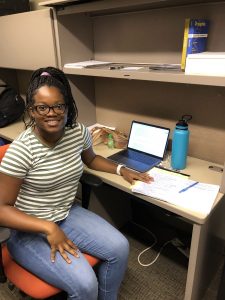So this week’s blog post is centered around my day to day experiences in the lab! I’ve had the title for this blog post since the day 1 meeting when Dr. Grunwald suggest we use interesting, creative titles for our blog posts. Anyways, on to explaining what I do in lab most days.
Usually, I start my days in lab around 10AM after the morning session with either faculty in the Biological Sciences or an informational session given by Dr. Grunwald or Anna.
The first thing I do when I get to lab is check on my morning fly check. This consists of me getting my fly babies (if you cannot tell I am very fond of my flies) that are in the incubator out and examining the vials looking for empty pupae cases. We keep flies in the incubator (25 degrees celsius) because it helps slightly speed up the development of the flies without causing any disruptions to development or manipulating any temperature sensitive mutations.
After checking on my crosses, I either transfer the adults from a cross into a fresh vial with new food to expand the cross or I will look for male and virgin female flies in order to set up a new cross. To look for flies, I first have to turn on LED light on the microscope and the CO2 gas which is filtered through water and to this small nozzle (I can control the release of gas through this nozzle manually). I can then shoot CO2 gas into the fly vial (I hold the vial upside down during this process –it keeps the flies from drowning in their food) which puts them to sleep. I then remove the cotton bung which plugs the vial and slightly tap the vial to get all the sleeping flies onto a pad. This pad (I like to think of it like a bed) is made of a porous material and is also attached to the hydrated CO2 causing the CO2 to be pumped onto the surface of the pad keeping the flies asleep while I sort through them using a paintbrush under the microscope. After I collect the flies I need to set up a cross, the other flies get funneled in the fly morgue (RIP fly babies).
Additionally during this check, I will also transfer freshly eclosed flies into a new vial if I am building a stock (flies that are all isogenic) in order to expand the stock (as my PI says, it’s always good to have a back up). After I am finished checking on my crosses/setting up new crosses, I return the flies back to the incubator so that they can continue aging. I repeat these same steps in the afternoon before I leave for the day as a part of my afternoon fly check.
After my morning fly check, I usually have a few options as to how to spend my day until I perform my afternoon fly check. The first week fo BSURF, I spent this time reading different fly protocols and literature about Drosophila. I also took time to understanding more about the purpose of the crosses I will be setting up and the different phenotypes that will result from a particular cross. My PI also uses this time to teach me a new technique that I will need for something I will be doing later in the day. There have also been points during BSURF where I set up blocks to collect eggs from specific lines of flies to mount on slides which would usually take me about 2 hours depending on how many block positions I had filled.
Currently, I spend the time between my fly checks either working on my blog post (which I am currently doing), making mockups of my presentation poster, or thinking/ researching about the next steps in my experiment given the questions my PI brings up for me to think about.
In the afternoon, I perform my fly check mainly to see if there are any freshly eclosed females of a particular genotype that I need to perform a cross. This is mainly because there is a window of about 8 hours that female fruit flies need to become sexually mature. Before this time frame passes, the female is too soft for a male to mate with thus the female flies I collect during this time have not mated. It is important for me to mate female virgins because that ensures that I know the possible genetic and phenotypic outcomes of the eggs she will lay since. If I pick an older female, I won’t know for certain the genetic combination of the eggs she lays.

Here’s a picture of the microscope and the CO2 bed




